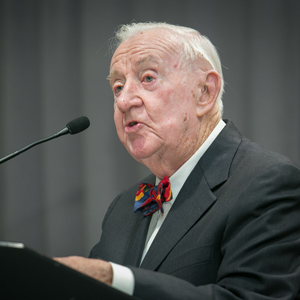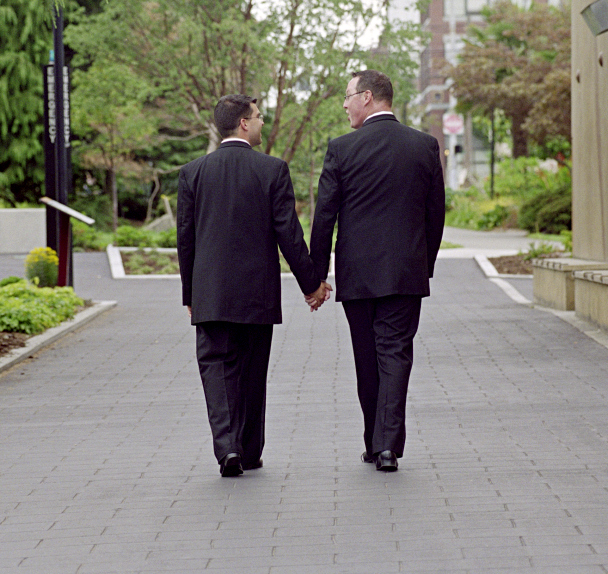Justice John Paul Stevens: Remembering a man of modesty, remarkable intellect

Retired Justice John Paul Stevens called for a "national solution" to the death penalty at the 2015 ABA Annual Meeting. Photo by ©Kathy Anderson.
U.S. Supreme Court Justice John Paul Stevens’ maverick ways started fresh every morning.
Stevens, who died July 16 at age 99 after suffering a stroke, once described why he preferred his trademark bow ties.
“When I try to tie a four-in-hand, the thin part of the tie works its way around to the front for some reason,” Stevens said in a 2012 interview at the Chicago-Kent College of Law, referring to a type of knot for long neckties. “It’s harder for me to tie a four-in-hand than it is to tie a bow tie. This is easier, and I must say, my dad wore a bow tie, and I was happy with it.”
“So, judicial economy and precedent,” quipped Nancy Marder, a Chicago-Kent law professor who was interviewing him before a crowd at the law school.
Respect for precedent and judicial economy were just two of the ideals that epitomized Stevens’ nearly 35-year tenure on the Supreme Court, from his nomination by President Gerald R. Ford in 1975 until his retirement in 2010, under President Barack Obama.
Stevens also embodied personal and judicial modesty, pragmatism, intellectual rigor and independence.
“Certainly, Justice Stevens looms large as a justice who did incredible work,” says Marder, who served two terms as a law clerk to him the early 1990s, and is now the director of Chicago-Kent’s Justice John Paul Stevens Jury Center, which undertakes scholarly projects on the jury system. “He always remained calm and optimistic,” she says.
‘A VERY APOLITICAL PROCESS’
In the wake of Stevens’ death, admirers spoke of him as the last of a breed of nominees chosen based more on his legal acumen than on political calculations of how he might rule or whether he would please particular camps.
“He was a product of a different era,” says William M. Treanor, the dean of Georgetown University Law Center, who long admired Stevens. “When President Ford selected him, it was a very apolitical process.”
When a vacancy arose with the retirement of Justice William O. Douglas, Ford said that all he wanted was “the finest legal mind I could find.” He found it in Stevens, a judge on the 7th U.S. Circuit Court of Appeals in Chicago who had worked as an antitrust lawyer and investigator of judicial bribery allegations.
Members of the U.S. Senate took an approach that looked nothing like the scorched-earth tactics surrounding modern high court nominations.
“As matters developed, no senator asked me a single question about any opinion that I had written,” Stevens wrote in The Making of a Justice: Reflections on My First 94 Years, an autobiography published just this spring.
Stevens was confirmed 19 days after his nomination, by a vote of 98-0.
Treanor was the dean of Fordham University School of Law in 2005 when the school held a symposium recognizing Stevens’ 30 years on the Supreme Court. The law dean received an unsolicited letter from Ford in advance of the symposium in which the former president said that he was “prepared to allow history’s judgment of my term in office to rest, (if necessary, exclusively) on my nomination 30 years ago of John Paul Stevens.”
“When I presented it to Justice Stevens at the event, he was clearly very moved and touched,” Treanor says. “He hung the letter on the wall of his chambers.”
Stevens was “really somebody who combined a remarkable intellect, a commitment to the rule of law, but also a warmth and humility that is extraordinary for someone of such accomplishments,” says Treanor, who frequently welcomes Supreme Court justices to address law students at Georgetown, as Stevens did in 2014.
Stevens became known as the leader of the court’s liberal wing, especially after the retirement of Justice Harry A. Blackmun in 1994. Stevens led on issues such as gay rights, procedural rights for detainees in the war on terror, and resistance to Chief Justice William H. Rehnquist’s efforts to promote federalism and greater state autonomy. He also voted consistently for abortion rights.
Stevens shifted left from more conservative positions he took early in his tenure on such issues as affirmative action and the death penalty.
Still, Stevens insisted that he remained a traditional judicial conservative while the court had shifted to the right around him.
“I don’t think of myself as a liberal at all,” Stevens said in an interview with the New York Times in 2007. “I think as part of my general politics, I’m pretty darn conservative.”
THE ‘FALLIBILITY’ OF THE JUSTICE SYSTEM
As oral arguments became more of a verbal contact sport when Justice Antonin Scalia joined the court in 1986, Stevens retained an old-fashioned courtliness.
“His manner at oral argument typified both his civility and the quality of his mind,” Justice Ruth Bader Ginsburg said in a public statement after Stevens’ death. “He preceded his questions with the politest ‘May I … ,’ then invited advocates to train their attention on the issue likely to be dispositive.”
Advocates put it another way, saying Stevens found the most genteel way to go for the jugular.
Jeffrey L. Fisher, a Stanford University law professor who clerked for Stevens and now argues frequently before the court, recalled that even in chambers, Stevens would politely ask his clerks, “Do you mind if I interrupt you for a minute?”
“He didn’t have a whiff of self-importance,” Fisher says. “He always had a sparkle in his eye and a verve for his job and for life in general.”
Stevens showed concern for the vast power of government to affect the lives of individuals, which was likely affected by seeing how his father and other relatives were treated when a family business, the massive Stevens Hotel on Michigan Avenue in Chicago, went bankrupt during the Depression.
Stevens’ father, grandfather, and uncle were charged with financial misconduct. His grandfather, James W. Stevens, suffered a stroke and did not face trial, while his uncle, Raymond W. Stevens, committed suicide. Only Stevens’ father, Ernest J. Stevens, went to trial and was convicted. But he conviction was overturned on appeal to the Illinois Supreme Court.
Stevens wrote in his recent autobiography that his “firsthand knowledge of the criminal justice system’s fallibility” reinforced his views that prosecutors make mistakes.
Stevens was the last Supreme Court justice to have served in World War II. After his undergraduate days at the University of Chicago, he studied naval intelligence, and joined the Navy on Dec. 6, 1941, the day before the Pearl Harbor attack.
His experience as a codebreaker during the war infused a sense of patriotism in Stevens that seemed to motivate him years later when he dissented from a decision of the court that the First Amendment protected those who would burn an American flag.
The American flag “is more than a proud symbol of the courage, the determination, and the gifts of nature that transformed 13 fledgling colonies into a world power,” Stevens wrote in his solo dissent in Texas v. Johnson in 1989. “It is a symbol of freedom, of equal opportunity, of religious tolerance, and of goodwill for other peoples who share our aspirations.
“Sanctioning the public desecration of the flag will tarnish its value,” he added, “both for those who cherish the ideas for which it waves and for those who desire to don the robes of martyrdom by burning it.”
Stevens served as a law clerk to Justice Wiley B. Rutledge for the 1947-48 term, and Rutledge had a profound influence on him. He kept Rutledge’s official portrait in his chambers. When Stevens wrote the 2004 opinion for the court in Rasul v. Bush that gave detainees at Guantanamo Bay the right to challenge their imprisonment in federal courts, he cited Rutledge’s vigorous dissent in a 1948 decision that had denied federal court jurisdiction for Germans being held for deportation at Ellis Island.
When Stevens joined the court, he became only the third former high court law clerk to join the bench, after Byron R. White, who had clerked for Chief Justice Fred Vinson, and William H. Rehnquist, who clerked for Justice Robert H. Jackson. Now five current members of the court—a majority—served as law clerks to justices.
A PROLIFIC RETIREMENT
When Stevens retired from the court in 2010, several of his former clerks showed up in the bar section wearing bow ties. Only recently did the public learn that the justice’s male colleagues on the court had also donned bow ties around that time for his private retirement party. (A photo appears in Stevens’ recent autobiography, and it demonstrates that not every Supreme Court justice looks as natural in a bow tie as Stevens.)
Stevens, then 90, redefined the concept of active retirement. He wrote two earlier books, Five Chiefs: A Supreme Court Memoir and Six Amendments: How and Why We Should Change the Constitution. The latter called for the nation to take action to prohibit political gerrymandering, reduce corporate influence on elections, repealing the death penalty and clarifying the Second Amendment to say the right to bear arms applies to only to those serving in a militia.
After last year’s shootings that killed 17 people at the Marjory Stoneman Douglas High School in Parkland, Florida, Stevens called for repealing the Second Amendment. The marches organized by student survivors “reveal the broad public support for legislation to minimize the risk of mass killings of schoolchildren and others in our society,” he wrote in a New York Times op-ed.
Stevens held his last clerk reunion this past spring near his home in Florida, where the justice had commuted from for more than 20 years before his retirement from the court. (He told C-SPAN that he would read briefs on the beach after taking his daily swim, and he once opened a brief while on the bench during oral argument and had to shake sand out of it.)
The reunion also celebrated Stevens’ 99th birthday and the release of his autobiography. Marder, of Chicago-Kent law school, says that at a brunch, Stevens was interrupted so often by former clerks seeking a few words that he barely had a chance to eat.
Fisher, of Stanford Law School, said, “We were all amazed by how sharp he was. His speech had slowed down a little, but his mind had not.”
See Also:
ABAJournal.com: “Retired Justice John Paul Stevens dies at 99”
ABAJournal.com: “Justices recall Justice John Paul Stevens as kind and decent; Kavanaugh shows no bitterness”
ABA Journal (2010): “Man of Moderation: Last Justice of ‘Greatest Generation,’ Says Farewell”
ABA Journal (2010): “Practical Meaning: As the Court Shifted Right, Stevens Kept His Place”
Photo Gallery: Justice John Paul Stevens’ 10 Most Influential Cases
Photo Gallery: The Childhood of Justice John Paul Stevens




